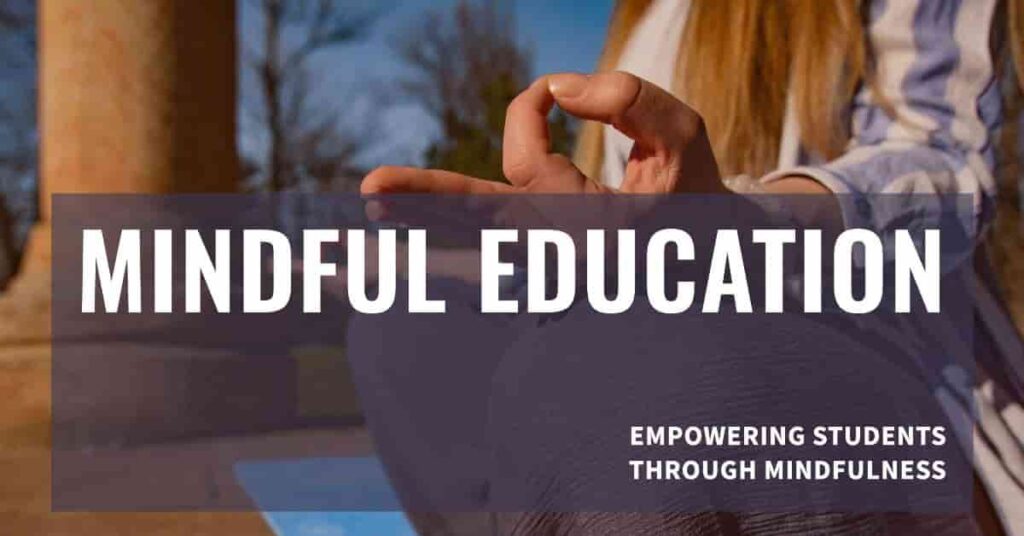The Power of Mindfulness in Education
In today’s classrooms, students face a multitude of challenges – academic pressure, social anxieties, and constant digital distractions. This frenetic environment can hinder their ability to focus, retain information, and cultivate a love for learning. Here’s where mindfulness steps in.

Mindfulness is the practice of paying attention to the present moment without judgment. By incorporating mindfulness practices into the classroom, educators can cultivate a calmer, more focused learning environment, fostering student well-being and academic achievement.
The Science Behind Mindfulness in Education
Research supports the positive impact of mindfulness in education. Studies have shown that mindfulness practices can:
- Improve focus and concentration:Mindfulness teaches students to become aware of distractions and gently redirect their attention to the task at hand (Zenner et al., 2014).
- Reduce stress and anxiety:Techniques like breathing exercises and meditation can help students manage stress and anxiety, leading to a more positive learning experience (Kabat-Zinn, 2013).
- Enhance emotional regulation:By being more aware of their emotions, students can learn to manage them effectively, leading to improved decision-making and social interactions (Zeidan et al., 2015).
- Increase self-awareness:Mindfulness practices can cultivate self-awareness, allowing students to identify their strengths and weaknesses, leading to better learning strategies (Schonert-Reichl & Satterfield, 2010).
- Greater empathy and compassion:Mindfulness can foster a sense of empathy and compassion, promoting positive social interactions within the classroom (Keng et al., 2011).
Cultivating a Mindful Classroom
Educators play a crucial role in creating a mindful learning environment. Here are some ways they can integrate mindfulness practices:
- Leading by example: A teacher who embodies mindfulness through their own behavior sets the tone for the classroom.
- Integrating mindfulness into the curriculum:Simple breathing exercises, short meditations, or mindful movement breaks can be incorporated into daily routines.
- Creating a calm and inviting classroom space:A well-organized and aesthetically pleasing environment can promote feelings of relaxation and focus.
Valdymas College: Nurturing Mindful Learners
At Valdymas College, we recognize the transformative power of mindfulness in education. We are committed to providing our students with the tools and strategies they need to thrive, both academically and personally. Here’s how we integrate mindfulness into the Valdymas College experience:
- Mindfulness curriculum integration:Age-appropriate mindfulness practices are woven into the curriculum across disciplines, fostering a holistic approach to learning.
- Dedicated mindfulness sessions:We offer dedicated mindfulness sessions led by trained professionals, providing students with a deeper understanding of mindfulness techniques.
- Mindful spaces throughout the campus:Designated quiet spaces are available for students to practice mindfulness exercises or simply find moments of calm reflection.
By fostering a mindful learning environment, Valdymas College empowers students to develop the focus, self-awareness, and emotional regulation skills essential for academic success and personal growth.
Conclusion
Mindfulness is not just a passing trend; it’s a powerful tool that can transform the educational experience. By integrating mindfulness practices and fostering a culture of well-being, educators can create classrooms that nurture focused,engaged, and successful learners. At Valdymas College, we believe that mindfulness is an essential part of a complete education, preparing our students to become confident, resilient, and lifelong learners.
References
- Kabat-Zinn, J. (2013). Mindfulness for everyone: Cultivating well-being in the face of life’s challenges. Hyperion.
- Keng, S. L., Rutledge, M., & Smeets, I. (2011). Compassion training: Current status and future directions. Current Opinion in Psychiatry, 24(6), 422-426. https://journals.plos.org/plosone/article?id=10.1371/journal.pone.0017798
- Schonert-Reichl, K. A., & Satterfield, B. S. (2010). A systematic review of the effects of mindfulness training on neurocognition and emotional regulation in non-clinical adults. Journal of Clinical Psychology, 66(8), 900-910.



